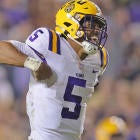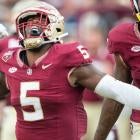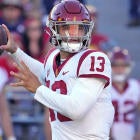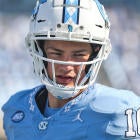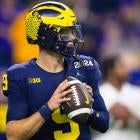In an unprecedented statement Monday, four major North American sports leagues said they would close locker rooms, clubhouses, and facilities to media and non-essential personnel.
The joint statement from NBA, MLB, NHL and MLS related to the spread of coronavirus was missing one essential member: the National Football League. The NFL is more than one month removed from the Super Bowl and another half-year from playing the first regular-season game of the 2020 season.
The NFL has the "luxury" (if you can call it that) of not having to take the lead on such a fluid situation. And though the league is saying all the right things about closely monitoring the situation for the owners meeting later this month and the 2020 NFL Draft in Las Vegas in late April, the fact is that the league has much more time than, say, the NCAA does as it relates to making a call on an event.
But just because the calendar for the NFL seems relatively empty does not mean there aren't—or shouldn't be—health concerns for all 32 teams during the offseason. And already teams are pulling coaches from their pre-draft circuit. More on that below.
I've spent the first part of this week reaching out to league and team sources about the hidden parts of the league's schedule and how certain smaller events on the calendar could be impacted as the world continues to grapple with the latest health crisis.
First comes free agency, which begins noon Monday with the opening of the legal tampering window and in full at 4 p.m. Eastern Wednesday. Teams will be flying in free agents from across the country next week for visits to the team facility in an attempt to woo them. Whether out of fear of contracting the virus or simply logistical issues with canceled or restricted flights, might the annual tradition of free-agent visits take a hit?
For those players who agree to deals, they have to sign a physical copy of their contract, though they can also do it via snail mail. Could an electronic system like DocuSign be better for a temporary period?
April 6 is also a major date for an eighth of the NFL. That's the first day players for the Browns, Cowboys, Giants, Panthers, and Washington can report to their respective team facilities to begin phase 1 of their offseason training activities (OTAs). Roughly 90 players plus coaches and team personnel will be gathering for the first time, all coming from across the country and some possibly coming off international travel.
Two weeks later, the rest of the NFL can begin OTAs. One NFC executive told me they were less concerned with offseason programs because it's a controlled population of players and personnel, and that makes sense. Still, those five teams with new head coaches could very well be the leaders in precautionary measures around the league.
But as universities across the country have started to move their classes online in the past 48 hours, what became clear to me is the issue NFL teams will likely have to reckon with in more real ways than any other: college pro days.
I can confirm the Steelers have adjusted their "travel plans temporarily as it pertains to pro day," according to team spokesman Burt Lauten. Though Steelers coaches were absent at Wednesday's Oklahoma pro day, head coach Mike Tomlin is expected to be at Clemson's pro day Thursday.
The Eagles have also pulled their coaches from the pro-day circuit. I'm told the Eagles are keeping coaches in house for a variety of reasons, including health but also to better prepare for free agency and work on schematics.
Representatives from all 32 teams usually descend on college campuses at the top schools. Dozens of media members are there, too. For example, anywhere between 100-200 people who would not normally be on campus will be at Clemson's indoor practice facility Thursday for the Tigers' pro day.
These pro days will stretch into April, and as essential as they are to NFL teams evaluating draft talent, they are hardly necessary to the function of higher education. Should colleges deem these events as non-essential, what becomes of the 2020 pro days?
Or, even if these pro days do continue, what if more teams don't show up? Companies across this country are telling their employees to work from home, and multibillionaire companies like individual NFL teams would be no different. Teams like the Steelers are being more judicious with their travel, and it would stand to reason that teams would be careful traveling to coronavirus hotspots. (The University of Washington's pro day, for example, is scheduled for March 31.)
Then there are the draft-prospect visits, otherwise known as top-30 visits. NFL teams get to fly in as many as 30 draft-eligible players to the team facility to learn more about each young man. Similar to free-agent visits, these players would be coming in from all over the country facing the same potential travel issues. And unlike the free-agent visits, which may number three or four at most, a first-round prospect could visit double-digit facilities during the pre-draft process. One agent told me top-30 visits "could be hugely impacted."
I don't at all mean to be an alarmist. I'm not advocating for anything other than common-sense measures that are backed by health officials the team either employs or consults with, along with information from health organizations.
In truth, the owner meetings in West Palm Beach, Florida, beginning March 29 can be done via teleconference. The NFL Draft, at its most basic, can be performed by a few dozen people in a room in Las Vegas with team personnel at their own respective facilities. That would, of course, be a massive financial blow to the city of Las Vegas and the league, and it would strip rookies of a once-in-a-lifetime experience, but the point is that it could be done.
But these other events in the typical NFL offseason calendar that aren't as high profile may very well be impacted in very real ways very soon. And because there are so many moving parts and various companies and institutions involved (plus all the money), it's hard to see the path toward a cohesive plan everyone will stick to.















